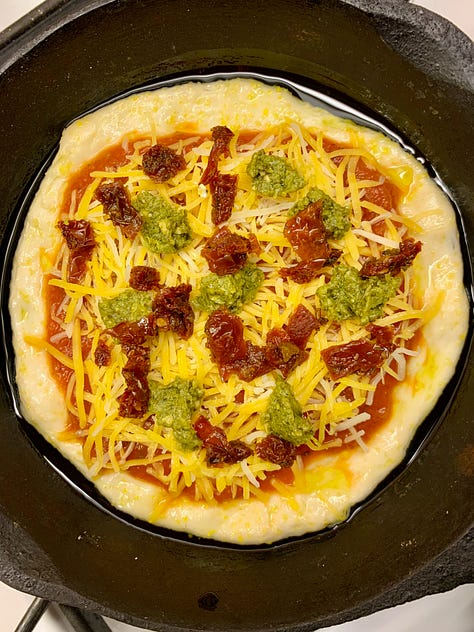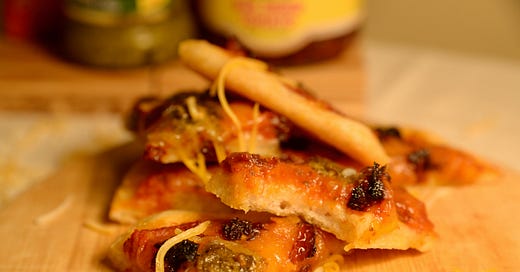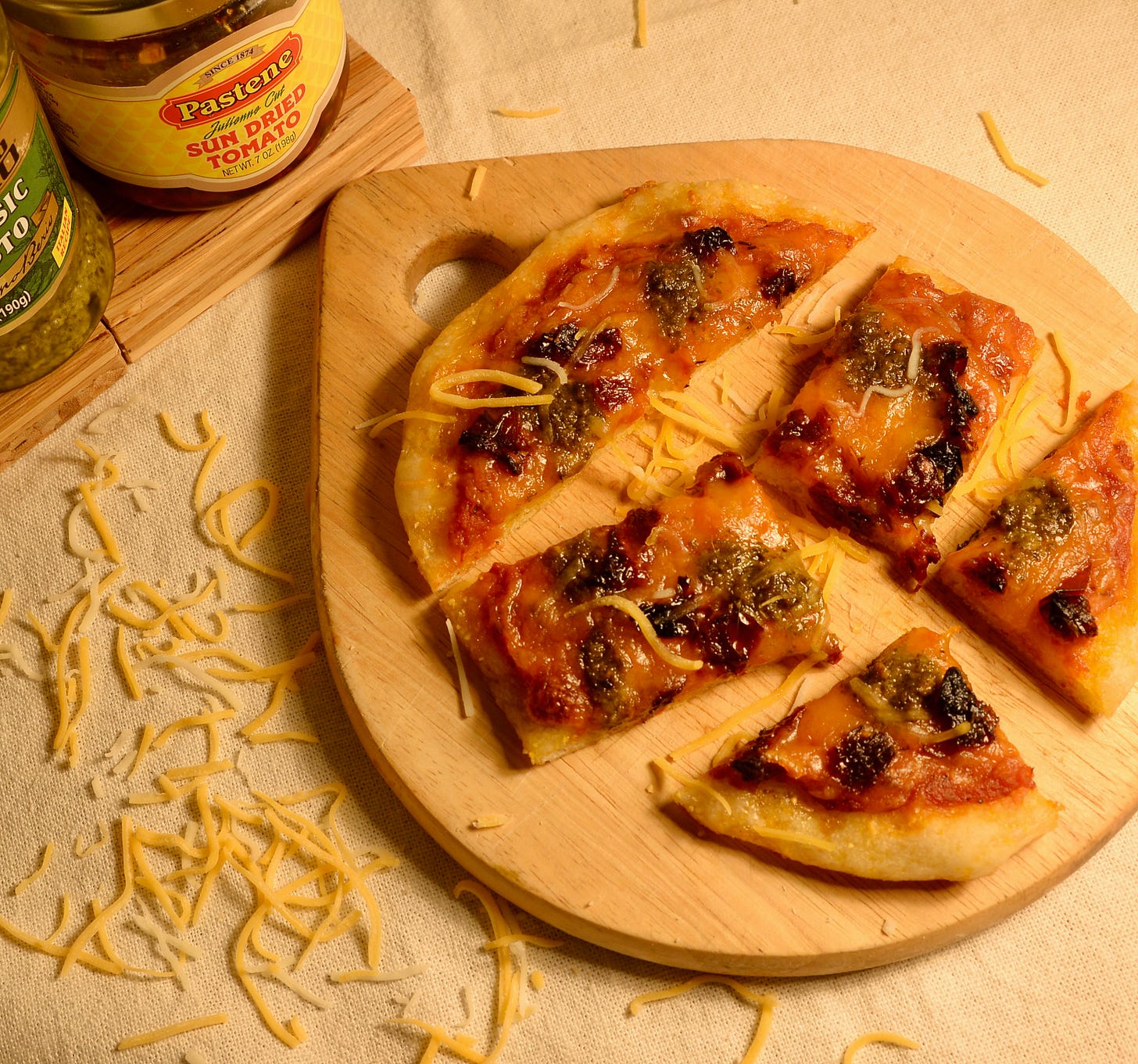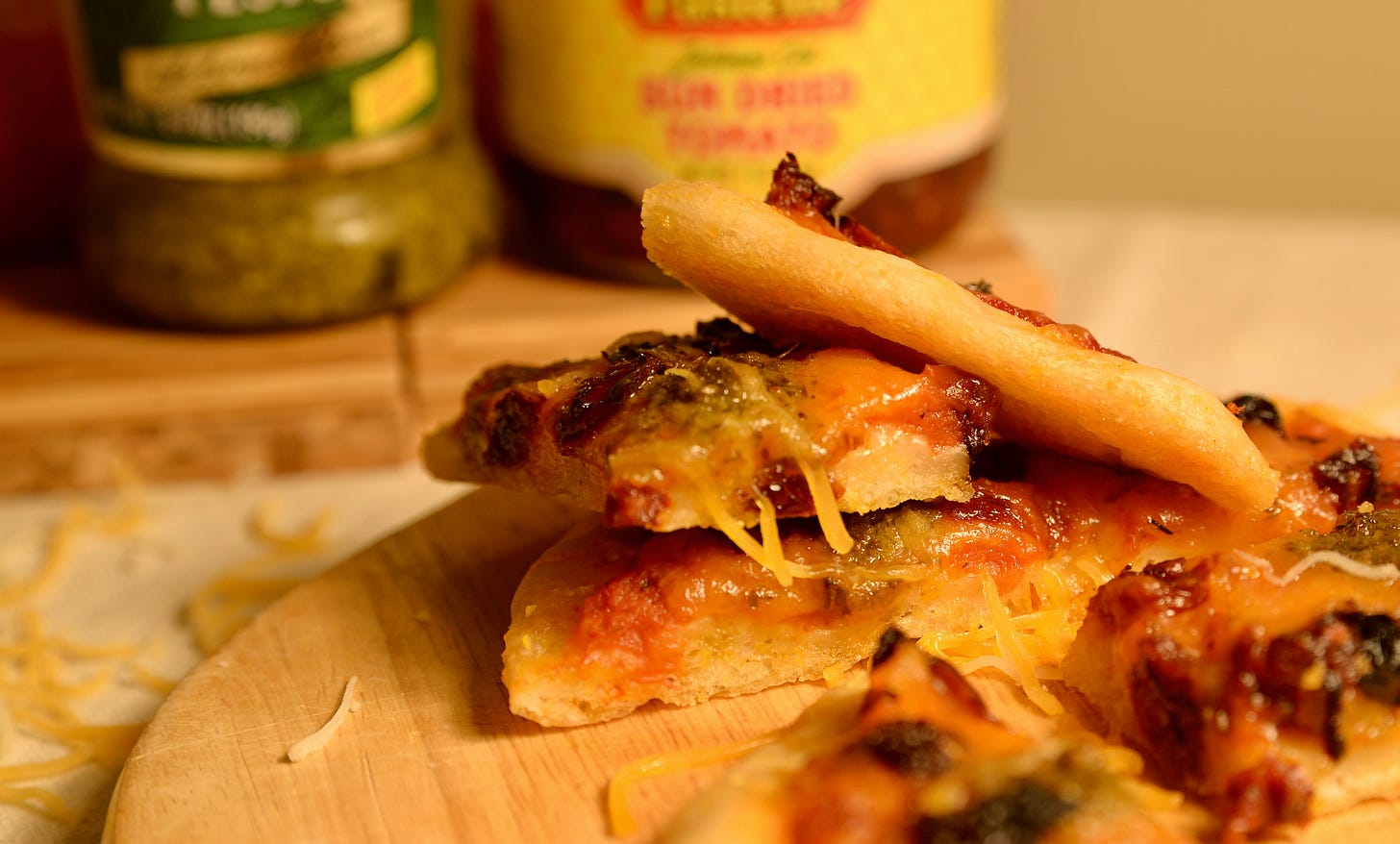Where did I put it?
I looked in all of the regular places. I checked the shelf on my baking island where my other flours were. I looked all through the drawer with the other dry goods, where I thought I would find it. I looked in the door of the freezer, where the last container was kept. I searched through the pantry shelves in the basement, knocking over jars of recently canned applesauce and being grateful they did not break. But still, I could not find my cornmeal.
This was driving me nuts. I had used my coarse grind cornmeal to make this pizza, and I was sure I had another container, which I wanted to use to make polenta as a base for the mushroom piccata I had planned for dinner.
I went back to check all of the same places for a third time. And I found it. In the freezer. Behind a loaf of bread and under a pack of bacon. But it was not the container I had been looking for, it was a bag of Bob’s Red Mill Medium Grind Cornmeal. Could I still make polenta with medium grind? Sure! Why not? But then as I stirred and my corn mixture thickened, I got to wondering what the purpose of the different grain sizes really were and if I really was making polenta or if I was making something else, like grits.
Bon appétit had a nice summary of the different sizes of ground corn. First of all, ground corn is field corn, which is not the same as the sweet corn we eat off the cob. Then, the corn is ground down to three different sizes, fine, medium or coarse. The different sizes have different characteristics, which account for their different purposes in cooking. The smaller the grind, the faster water gets absorbed and the less time it takes to cook. This makes fine and medium ground corn good for everyday things that bake in a short amount of time, such as cornbread, muffins or pancakes. Coarse cornmeal is used where you want to feel the texture, such as breading, flour-free cornbread or blueberry crisp topping.
I like the texture when I bake with cornmeal, so I always buy coarse cornmeal. Well, almost always. Apparently I had a bag of medium grind in my freezer, which I was attempting to make polenta with. But my polenta was disqualified by the size of my corn bits.
The Bon appétit article went on to explain that polenta is made with yellow coarse cornmeal and grits are made with white coarse cornmeal. Since I was using my medium grind cornmeal, my corn mush could not be labeled as true polenta.
No matter. I had enough coarse cornmeal to use in a small batch of this Cornmeal Skillet Sourdough Pizza recipe that I got excited about as soon as I saw it. Like many great things in life, it was delivered to me in an email.
was sharing her new recipe on her Substack publication, Baker's Notes In addition, the recipe was featured on Maurizio Leo’s website, The Perfect Loaf. While Jennifer’s Substack is relatively new to me, I have found her words valuable and have improved my baking because of them. And I’ve been a long time subscriber of Maurizio’s newsletter of the same name as his website. The two have collaborated in the past and I am often drawn to their work.So when Cornmeal Skillet Sourdough Pizza rolled into my inbox, I was intrigued, but when I learned who the people were behind it, I was interested in trying it myself. The recipe Jennifer wrote is for two 10” cast iron skillets. It looks fabulous at that size, but my toaster oven was equipped for my little 6” cast iron pan and that’s what I reduced the recipe to fit.



Here is Jennifer Latham’s recipe for Cornmeal Skillet Sourdough Pizza reduced to a 6” skillet, and here is how I made it happen.
ingredients
Cornmeal porridge
4.5g coarse ground cornmeal
22g water
Main dough
37g high protein flour (I used bread flour)
14g water
0.88g salt
9g ripe starter
directions
Cook the cornmeal and water mixture on the stove top and stir until thick. Then, let cool to room temperature. This was a small amount of cornmeal and the whole mixture thickened within 3 minutes.
Mix the flour, water, salt and starter together with the cornmeal mixture.
Let rise in a warm location for 20 minutes.
Complete bowl folds for another 5 minutes. This is where you fold the outside edge of the dough in on itself and keep repeating as you rotate the bowl.
Let the dough rest for about 3 hours in a warm spot. The original recipe calls for a temperature of 82oF. If you can make that happen, do it. My house was in the mid 60’s on that day, so I let it sit out while I went to work, then finished with the recipe when I got home.
Coat the bottom of the cast iron skillet with some olive oil. Then sprinkle some cornmeal in it.
Add the dough and gently press and stretch it with your fingertips until it reaches the edge of the pan.
Preheat the oven to 500oF
Let it rise for about an hour in a warm location. Press out to the edges if it didn’t make it there the first time.
Add your favorite toppings and bake for about 20 minutes or until the edges are golden brown. I had to turn the temperature down about half way through since my toppings were cooking faster.
Remove from the pan and let cool on a rack or serve immediately.
This pizza had a great crunch at the crust edge. As promised, the coarse cornmeal gave it a nice texture that accompanied my pesto and sun-dried tomato topping beautifully. Would I try it with a different cornmeal size? Definitely not. I like the large pieces of corn bits. Would it work with what you have? Absolutely.







A great introduction to the dizzying world of cornmeal color and grind size. The fact it is field corn was surprising to me. Growing up we called this corn called it ‘cow corn’ (used to feed dairy cows) and used it in our slingshots when it matured and hardened in the fall. LOL.